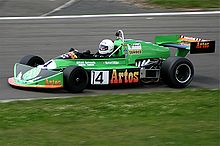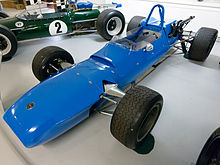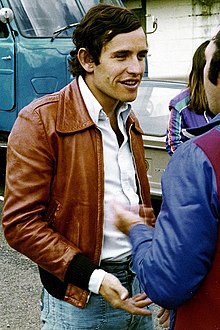Formula 2 European Championship
The Formula 2 European Championship was a racing series in automobile sport organized by the FIA from 1967 to 1984 that followed the Formula 2 regulations . It was a pure driver championship; there was no trophy for designers.
background
Formula 2 has been the highest junior class below Formula 1 since 1947 . Until 1960, numerous races were held annually in Great Britain and on the European continent according to the Formula 2 regulations. In some years there were national Formula 2 championships, for example from 1956 to 1960 in Great Britain; however, there was no international championship. When the Formula 1 regulations were adapted to those of Formula 2 from 1961 , there was initially no longer an independent Formula 2; Her role was temporarily taken over by Formula Junior , which later became Formula 3.
Formula 2 only revived in 1964. In addition to a British one, a French Formula 2 championship was announced this year, which was called Trophées de France . It was the success of this series in particular that prompted the Commission Sportive Internationale (CSI), as the responsible supervisory authority, to announce a European Championship for Formula 2 from 1967. In the 1970s, it became the most successful junior series in international automobile racing: "Anyone who wanted to enter Formula 1 had to compete in Formula 2." It was initially considered inexpensive, but also demanding. It was only at the beginning of the 1980s that running a Formula 2 team became significantly more expensive due to more technically sophisticated solutions, so that the championship became less attractive. In 1984, the last year of the championship, only 16 drivers competed in individual races, while a few years earlier there were more than twice as many.
At the end of 1984, the European Formula 2 Championship was discontinued, while the Japanese parallel series existed for two more years. The end of the European series followed indirectly from the conversion of Formula 1 to turbo engines. The FISA had an interest in using the DFV naturally aspirated engines from Cosworth , which were superfluous in Formula 1 due to the dominance of turbo engines, in races. This gave rise to the idea of Formula 3000 as a new junior series below the Turbo Formula 1. Initial plans envisaged that the Formula 2 European Championship should be held for the last time in 1983. Considerable resistance from the team owners led to Formula 2 being retained until 1984.
run
The races of the Formula 2 European Championship were regularly held separately from Formula 1 and on other tracks.
Some of the Formula 2 championship races were events that had previously been advertised for Formula 1; there they were mostly side races without championship status. This applies, for example, to the BRDC International Trophy in Great Britain, the Grand Prix de Pau in France and the Gran Premio di Roma in Italy. In 1969 an attempt was made to revive the Gran Premio di Siracusa , a traditional, championship-free Formula 1 race in Sicily , which has since been discontinued , as a Formula 2 championship run; however, these efforts failed.
Occasionally there was a joint appearance of Formula 1 and Formula 2 cars. This was primarily true for some races on the German Nürburgring. In 1966 , 1967 and 1969 , Formula 2 cars were also allowed at the German Grand Prix , which were part of the Formula 1 World Championship. The reason for the opening of the starting field was the extraordinary length of the course. Given a lap length of more than 22 kilometers, only 14 laps were driven. In order to provide more entertainment value for the audience, the organizers allowed additional cars. Both classes drove at the same time, but were rated separately. The Formula 2 drivers therefore did not receive any points for the Formula 1 World Championship. The races did not count towards the Formula 2 European Championship, but were championship-free races for Formula 2.
driver
The Formula 2 European Championship was considered a junior series. In it, young drivers with no experience in Formula 1 competed for the championship title. They were called B-drivers .
Regardless of this, until the 1970s, drivers with Formula 1 experience also regularly competed in races in the Formula 2 European Championship. They were as Graded Drivers ( ger .: classified / rated driver ) or A-Driver called. You have not been awarded any points for the European Championship. This was already noticeable in the first year of the championship: Jochen Rindt , who was already established in Formula 1, won all five rounds of the Formula 2 European Championship he competed in, but received no points for them. Instead, the championship went to B-driver Jacky Ickx , who only won two championship races.
The main reason for the established A-drivers to take part in Formula 2 races, in addition to collecting further racing practice, was above all the high entry fees and victory bonuses. With the increasing complexity of Formula 1, which among other things led to an increase in test drives between the individual Formula 1 races, the attractiveness of Formula 2 for A drivers declined.
Designers and engine manufacturers
Over the years, vehicles have been used by around 20 designers in the Formula 2 European Championship. In the first few years, manufacturers such as Brabham , Cooper , Ferrari , Lotus , Tecno and later Surtees also produced Formula 2 chassis. These manufacturers initially took part in the European Championship with their own factory teams, but also made their cars available to independent customers. At the beginning of the 1970s, many works teams withdrew from the European championship; Brabham, Ferrari and Lotus then also stopped chassis production. March Engineering then became the dominant manufacturer , which had its own factory team and which also produced up to 20 chassis per year for customers. Chevron , Lola and Ralt adopted this concept in the 1970s, but were less successful than March in the long run. March vehicles dominated the starting fields in the European races until 1984. There were also various small manufacturers who produced vehicles primarily for their own factory teams: they included AGS , Martini , Maurer , Merzario , Minardi and Osella .
The engines initially came mainly from Ford and Cosworth . They were BDA engines based on a Ford series block. In the early 1970s, BMW took on a central role in Formula 2. First, March had an exclusive contract with BMW for his works team, whose drivers were in 1973 ( Jean-Pierre Jarier ), 1974 ( Patrick Depailler ), 1978 ( Bruno Giacomelli ), 1979 ( Marc Surer ) and 1982 ( Corrado Fabi ) won the Formula 2 European Championship with BMW engines. From 1974 the BMW engine was also available for other teams. In contrast to the March works team, the customer engines were not prepared by BMW itself, but by independent tuners such as Mader in Switzerland, Heidegger in Liechtenstein or Osella and Amaroli in Italy. The BMW engine quickly became the most widespread drive unit in European Formula 2.
In some years engines from Renault , Honda and Hart were also successful. Ferrari's engines were no longer common in Formula 2 after the factory team withdrew; only the Minardi team used them in individual races for a few years.
Records
The driver with the most victories in the European Championship was Jochen Rindt, but not a single one of his twelve victories counted for the championship, as he received no points as an A driver. Thus, Bruno Giacomelli's eleven wins are considered the best result. Giacomelli also achieved the most pole positions with eleven first places on the grid . New Zealander Mike Thackwell achieved the most points with 164 . The youngest rider to win a championship run was American Eddie Cheever , who was 19 years and 168 days old when he won 1977 in Rouen . The oldest rider to win a race was Graham Hill , who was 42 years and 56 days old at Thruxton in 1971. The closest finish came in 1968 at the Gran Premio del Mediterraneo in Enna , when Jochen Rindt, Piers Courage , Ernesto Brambilla and Clay Regazzoni crossed the finish line within a tenth of a second in that order.
master
| year | driver | dare |
|---|---|---|
| 1967 |
|
Matra |
| 1968 |
|
Matra |
| 1969 |
|
Matra |
| 1970 |
|
Tecno |
| 1971 |
|
March |
| 1972 |
|
Surtees |
| 1973 |
|
March |
| 1974 |
|
March |
| 1975 |
|
Martini |
| 1976 |
|
Jabouille |
| 1977 |
|
Martini |
| 1978 |
|
March |
| 1979 |
|
March |
| 1980 |
|
Toleman |
| 1981 |
|
Ralt |
| 1982 |
|
March |
| 1983 |
|
Ralt |
| 1984 |
|
Ralt |
literature
- David Hodges: Racing Cars from A – Z after 1945. Motorbuch-Verlag, Stuttgart 1994, ISBN 3-613-01477-7 , p. 116.
- Eberhard Reuß, Ferdi Kräling: Formula 2. The story from 1964 to 1984 , Delius Klasing, Bielefeld 2014, ISBN 978-3-7688-3865-8
Web links
Individual evidence
- ↑ Eberhard Reuß, Ferdi Kräling: Formula 2. The story from 1964 to 1984 , Delius Klasing, Bielefeld 2014, ISBN 978-3-7688-3865-8 , p. 45.
- ↑ Eberhard Reuß, Ferdi Kräling: Formula 2. The story from 1964 to 1984 , Delius Klasing, Bielefeld 2014, ISBN 978-3-7688-3865-8 , p. 192.
- ↑ Race Report for the Grand Prix of Germany in: auto motor und sport, issue 17/1969.
- ↑ a b Eberhard Reuß, Ferdi Kräling: Formula 2. The story from 1964 to 1984 , Delius Klasing, Bielefeld 2014, ISBN 978-3-7688-3865-8 , p. 46.




